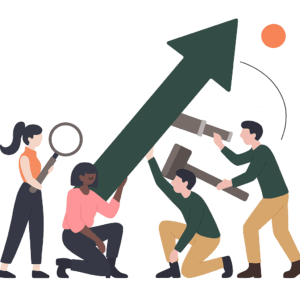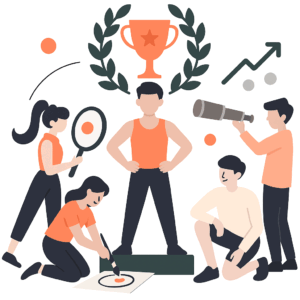Goal Setting Beyond Sports: Applications in Personal Development, Talent Development, and Strengths-Based Leadership
Meta-analysis ^1 reveals the cognitive mechanism behind goal setting: process goals enhance self-efficacy, which drives performance improvements. Goals focused on self-improvement produce better psychological outcomes than goals about beating others.
This research indicates that goal setting principles transcend athletic environments and offer powerful frameworks for personal growth, organizational leadership, and talent development. In this article we will focus on how we can be inspired by the sport field and apply similar approaches to development of skill and competencies in a business context.
Achieving personal growth through education? job challenges? team challenges? or just a which of not being left behind. No matter your motivation, some way of thinking about where to go and how to get there will benefit your path.
Goal Setting in Personal Development Contexts
Personal development goal setting has emerged as a cornerstone practice for individuals seeking intentional growth. Unlike sports-specific goals that might focus on performance metrics, personal development goals target holistic improvement across multiple life domains.
TalentInsights research highlights that effective personal development goals require understanding where you want to grow and how you’ll measure progress. Critically, these goals must align with personal values and skills to maintain authenticity^3. This alignment differs from sports goal setting, which might prioritize performance outcomes over value congruence.
The SMART framework (Specific, Measurable, Attainable, Relevant, Time-bound) remains foundational across contexts. Studies show people who document their goals and share weekly progress reports with others significantly increase their likelihood of achievement compared to those who merely think about goals^3. This written commitment mechanism appears consistent across both sports and personal development domains.
Common personal development goals that demonstrate this approach include:
- Improving time management
- Learning new skills
- Boosting self-confidence
- Enhancing emotional intelligence
- Developing public speaking abilities^8
These goals focus on holistic competency development rather than discrete performance metrics more common in sports contexts.
Goal Setting in Talent and Professional Development
Organizational contexts have adapted goal setting principles to foster employee growth and business outcomes. Talent development strategies particularly emphasize aligning individual goals with broader organizational objectives.
For effective talent development through goal setting, research indicates four essential steps:
- Setting SMART goals
- Creating performance plans with integrated learning components
- Incorporating experiential learning and peer learning opportunities
- Establishing clear milestones for progress tracking^4
Critical to successful professional development goal setting is ensuring employees see clear connections between their personal goals and the organization’s long-term objectives. This alignment creates dual benefits: employees perceive investment in their career trajectories while organizations build capabilities aligned with strategic needs^9.
Leaders implementing goal-setting practices within teams have found success by:
- Involving team members in the goal-setting process to enhance ownership
- Incorporating goal discussions into regular performance reviews
- Setting both short-term and long-term objectives to create sustainable growth paths^10
The integration of learning with performance goals represents a key distinction from traditional sports goal setting, which may emphasize achievement over developmental processes.
Strengths-Based Approaches to Goal Setting
Perhaps the most significant evolution in goal setting theory comes from strengths-based approaches, which fundamentally reorient goal setting away from deficit-focused improvement toward leveraging existing capabilities.
Strengths-based goal setting shifts from overcoming weaknesses to strategically applying natural talents toward desired outcomes. Research from Gallup defines a strengths-based goal as one that “draws on your natural talents to make positive and lasting change in your life while challenging you to use your talents in new ways”^12.
This approach demonstrates several distinct advantages over traditional goal setting:
Focus on Existing Capabilities
Traditional goal setting often begins with identifying gaps or weaknesses. In contrast, strengths-based goal setting starts by assessing natural talents and capabilities. Tools like the CliftonStrengths assessment or TalentIndikator ^7 test help individuals identify their core strengths as a foundation for goal development^6.
For example, rather than setting a goal to “email five additional sales leads daily” (deficit-focused), a strengths-based approach might reframe this as “email five additional sales leads daily using my Individualization strength to personalize outreach” (strength-leveraging)^13.
Enhanced Engagement and Motivation
Research indicates that when individuals focus on strengths-based goals, they experience:
- Up to 6 times higher engagement levels
- Greater intrinsic motivation
- Increased innovation and creativity
- Stronger sense of ownership and agency^7
This motivational advantage appears consistent across both personal and professional contexts.
Team Complementarity
In leadership contexts, strengths-based goal setting extends beyond individual development to team composition. Research from Rath and Conchie identified four strength domains essential for balanced teams:
- Executing: Turning ideas into reality
- Influencing: Selling ideas and leading action
- Relationship building: Creating emotional connections
- Strategic thinking: Processing information and developing concepts^7
Leaders using this framework set goals that leverage complementary team strengths rather than expecting uniform excellence across all domains.
Practical Implementation of Goal Setting Across Contexts
Despite contextual differences, several common implementation strategies emerge across personal development, talent development, and strengths-based approaches:
The SMART Framework
The SMART criteria remain foundational across contexts, though with nuanced applications. In leadership settings, SMART goals often incorporate team input and organizational alignment^5. In personal development, they emphasize personal values and intrinsic motivation^30.
Regular Review Mechanisms
Consistent across contexts is the importance of regular progress reviews. In organizational settings, this often integrates with formal performance management processes^10. In personal development, self-monitoring approaches like journaling or progress tracking tools are recommended^3.
Alignment with Values and Purpose
Regardless of context, goal setting effectiveness correlates with alignment to deeper values and purpose. In strengths-based approaches, this means connecting goals to natural talents^12. In talent development, it requires linking individual goals to organizational mission^9.
Conclusion: The Evolution of Goal Setting Theory
While sports psychology pioneered much of goal setting theory, its applications have evolved significantly across personal development, talent development, and strengths-based leadership domains. The research suggests several key distinctions in these contexts:
- Sports goal setting often prioritizes performance outcomes, while personal and professional development contexts emphasize growth processes alongside results.
- Strengths-based approaches represent a paradigm shift from deficit-based improvement to talent optimization, with emerging evidence suggesting higher engagement and motivation.
- Organizational goal setting uniquely emphasizes alignment between individual goals and collective purposes, creating dual benefit pathways.
Despite these differences, core principles like specificity, measurement, and regular review remain consistent across domains. The evidence suggests goal setting offers universal mechanisms for human development while allowing context-specific adaptations to maximize relevance and effectiveness.
The continued evolution of goal setting theory across these domains suggests ongoing opportunities to refine our understanding of how structured goal pursuit contributes to human development in its many forms.


